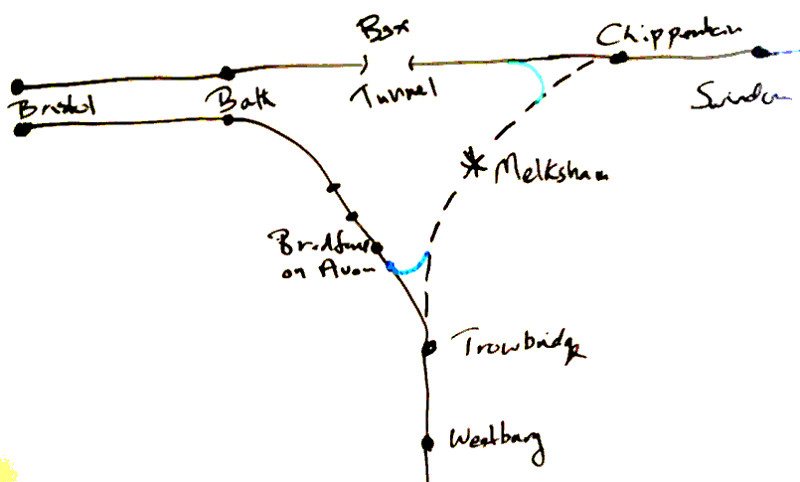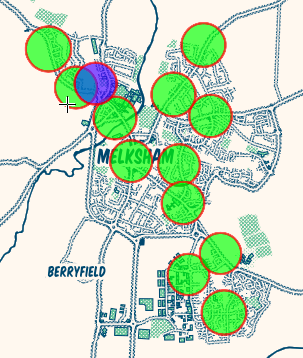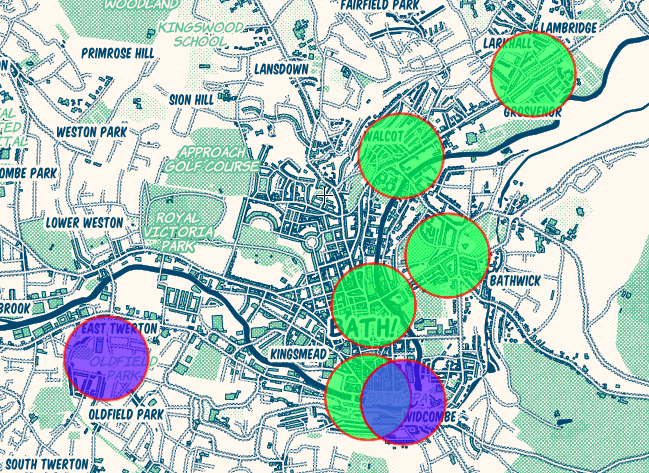"What about direct trains from Melksham to Bath (and Bristol)" ... a question that's been asked many times over the years. Here, with personal views included in the answers, is an update from me - looking very much from a Melksham viewpoint, but explaining options and their wider effects too.
BackgroundThe railway line through Melksham runs to the north east (to Chippenham and Swindon) and to the south (Trowbridge and Westbury), with up to 9 local passenger trains per day in each direction. The line joins the Bristol and Bath to Reading and London line at Chippenham, and the Bristol and Bath to Salisbury, Southampton and Portsmouth line at Trowbridge, and passengers from Melksham wishing to travel to Bath and Bristol can catch any of the up to 18 trains per day and change at either Chippenham or Trowbridge onto services on the other lines which typically run every 30 minutes, and are planned to step up to 3 services per hour in the future.
Many people want to travel from Melksham to Bath and Bristol, and would like a direct train service. The question is often asked "could a curve be reinstated at Bradford Junction" - that's near Trowbridge - to turn the junction into a triangle and allow direct running to Bath. I have also been asked if the south to west curve at Thingley Junction (near Chippenham) could be restored to give direct running from Melksham to Bath and Bristol.
The curve at Bradford Junctions was only removed in (about) 1990, and it's my understanding that the trackbed is still available and the line could be restored - indeed it was proposed that it should be done prior to the electrification works at Box Tunnel a couple of years ago so that trains from London to Bristol could be diverted between Chippenham and Bath. In the end, they added a signalling ability to reverse the trains just south of the junction near Trowbridge, and footpaths along the track to allow crew to change ends. Blue on map. The curve at Thingley was removed soon after the second world war, and restoration would be much more problematic. Green on map.

As well as 18 passenger train journeys, Melksham station sees a number of freight trains passing through each day - a very variable number but 10 would not be untypical. And at times of engineering or other disruption of other lines, longer distance trains are also diverted through. All of this on a single track without intermediate signal - an absolute maximum capacity of 3 train per hour, and no-where at either Chippenham or Trowbridge to sidetrack a train that's waiting for the single line - such waiting trains block the main line.
ThoughtsThere is scope for some increase from 9 stopping trains each way per day through Melksham, perhaps adding a very early service, a service for Swindon between 07:49 and 10:02, a service back from Swindon between 15:15 and 17:36, and a late evening round trip. Each and every one of those would generate significant new business. With each extra, that is 13 stopping trains each way per day.
Further services, lifting the line to hourly all day, every day would also generate more traffic but on the current infrastructure would lead to unstable timetabling, and long lay-overs of trains at Swindon. The instability would be particularly awkward because long distance freight trains tend not to be good timekeepers, and furthermore these freight trains need to find paths between Swindon and Chippenham in amongst all the high speed
IET▸ trains; a slow freight between two IETs will eat up a number of "paths" as it trundles along.
Splitting the maximum service on the current infrastructure headed for Trowbridge to (say) 6 trains to and onward from Westbury, and 6 trains to Bristol Temple Meads via Bath Spa would result in two very thin services. It would disadvantage Swindon / Chippenham to Trowbridge / Westbury passengers (who make up over half the traffic on the current trains) and it would feed a number of awkward, odd, off-pattern trains into the Bath to Bristol corridor. I also question the extra operating cost of this route to Bristol rather than Westbury - it might require an extra train and crew. Far better (in my view) to provide a robust service to Bath and Bristol involving a change at either Trowbridge or Chippenham - with that you have 24 journey opportunities per day with changes, as opposed to the headline "6 direct trains". Diverting half the trains to Bath and Bristol also precludes the planned linkage of the TransWilts service into Westbury - Salisbury and Salisbury - Solent trains for which there is a strong economic, operational and business case.
There is also a frequent bus service from Melksham to Bath - up to 4 buses an hour (3 on Saturday, every 2 hours on Sunday) with evening buses 6 days out of 7. These services have the advantage of serving multiple locations within Melksham and Bath; not everyone wants Melksham Railway Station, nor Bath Spa (or Oldfield Park) stations. Provision of half a dozen trains each day would largely compete with these buses from a Melksham perspective, abstracting passengers from them and potentially reducing their viability. Diagram shows 250 metre catchments around railway stations (blue) and major bus stops (green)


For passengers from Melksham to Bristol, a change of train at Trowbridge or Chippenham, or a change from bus to train at Bath Spa (or to the x39 Bath to Bristol bus) offers a sensible service. Connections, integrated information systems, and tickets that are valid on First's buses or First's trains (you would have thought - same company ...) could really do with improvement.
Looking further aheadThe text above offers, I'm afraid, some pretty powerful reasons why the current train service through Melksham should not be diverted to Bath and Bristol. Nor should it be diverted, even partially (you may argue for one peak service) when increased to the practical current line capacity of around 12 trains each way per day.
Looking further ahead, though ... there is a good case for stepping the service up to hourly, and an expectation that freight will increase during
HST▸ construction with new traffic from Westbury and to Quidhampton. Stone traffic from the Mendips is likely to increase, and the route forms part of an important backup highway from Southampton to the Midlands and the north of England. Such a step up would require substantial extra infrastructure, with either passing loops or a (near) complete doubling of the route, and with signalling to allow trains to pass along at shorter headways. The track was in any case double until 1967(ish) and whilst the remaining track has been slewed into the centre of the trackbed a lot of the way, and cuttings and embankments may have degraded, it wouldn't be an impossible task to redouble; a couple of pinch points such as the Avon bridge, and an issue with track cant at Thingley if the lines joined in a double junction.
A doubling of the line at Melksham would result in a substantial station rebuild; an alternative is to have a single track section through the station, and single track leads at both Thingley and Bradford Junctions, with two long dynamic loops. That even has some advantages over a plain double track, such as the ability for a slower freight train that's in the way or awaiting the main line to be overtaken.
With all the redoubling works under way, and with all
GWR▸ IET trains now diesel as well as electric powered, the case for re-instating the Bradford North Curve at the same time to provide for operational robustness should be looked at.
With an hourly passenger train each way at Melksham, logic still remains to run the services all to Trowbridge and Westbury, as the dilution and clock face arguments of doing otherwise still apply. However, there becomes an argument for the third train from Bristol running via Bradford-on-Avon to divert via Melksham - to Chippenham terminating there in a relaid bay, or to Swindon. With this frequency, the arguments about a diluted train service from Chippenham to Trowbridge are much reduced, and flows which are very awkward by public transport at present such as Swindon and Chippenham to Bradford on Avon are addressed. But please bear in mind that this is so many steps ahead of where we are today and things are likely to change our of recognition before it happens.
As a final note, ideas have been floated about a "Corsham Parkway" station at Thingley Junction, where the linees join and close by the A350 trunk road, and about a "Staverton" station at Bradford Junction where the lines meet. "Corsham Parkway" was, I think, just an idea that was quickly kicked into touch. "Staverton" may get considerable further exposure, being an interchange for faster journeys Melksham to Bath and Bristol and Chippenham to Bradford-on-Avon, an opportunity to pull traffic from Bradford-on-Avon where they have a severe problem with car fumes and dirty air, and also a station for much local traffic within walking distance of the station.


